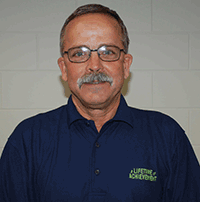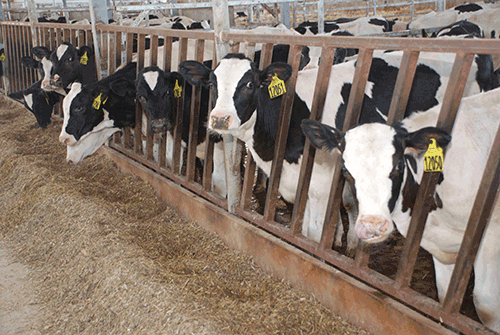
 Raising dairy replacement heifers is a significant investment for most dairy operations. Monitoring performance and making adjustments as an investment grows is a key to optimizing return on investment. Without measuring calf growth from birth to weaning, post-weaning to breeding age, and then from breeding age to calving, dairy producers cannot effectively measure the return on their investment. That's according to Gary Geisler, a calf and heifer specialist with Purina Animal Nutrition, located in Wisconsin.
Raising dairy replacement heifers is a significant investment for most dairy operations. Monitoring performance and making adjustments as an investment grows is a key to optimizing return on investment. Without measuring calf growth from birth to weaning, post-weaning to breeding age, and then from breeding age to calving, dairy producers cannot effectively measure the return on their investment. That's according to Gary Geisler, a calf and heifer specialist with Purina Animal Nutrition, located in Wisconsin.Set goals
 To effectively monitor growth rates, plan on evaluating calf and heifer growth every three months. If frequent monitoring is not possible for all age groups, focus on the youngest animals, says Geisler.
To effectively monitor growth rates, plan on evaluating calf and heifer growth every three months. If frequent monitoring is not possible for all age groups, focus on the youngest animals, says Geisler.Geisler references the Dairy Calf and Heifer Association Gold Standards as a guide to setting the following calf growth goals.[1]
Young calves (birth to 180 days of age):
- Double birth weight from 24 hours to 60 days of age
- Maintain 2.2 pounds per day average daily gain from 61 to 120 days of age
- Achieve 2.0 pounds per day average daily gain from 121 to 180 days of age
Breeding age heifers (13 to 15 months of age):
- Weight of 825-900 pounds (or 55 percent of the weight of mature cows in the herd)
- Hip height greater than 50 inches
- Wither height greater than 48 inches
Pre-fresh heifers:
- 1,350 pounds (or 85 percent of the weight of full-term, pregnant, mature cows in the herd)
- Body condition score at freshening of 3.5 (on a 5-point scale)
- Target a 1.7 to 2.0 pounds per day average daily gain from birth to pre-fresh
Monitor performance
An effective growth monitoring system hinges on time and equipment, notes Geisler. If planning a new calf facility is on the horizon, an efficient infrastructure for monitoring calf growth is highly recommended.
A more likely scenario, notes Geisler is that calf raisers must make-do with existing facilities. This he says shouldn't stop dairy producers from monitoring performance, as there are ways calf raisers lacking optimal facilities or the manpower effectively monitor calf growth, says Geisler.
Monitor group weight
When moving calves regularly with trailers from one pen/barn to another weigh the empty trailer and then again once loaded to catch the group weight. In most cases, the calves will be roughly the same age, so an estimated average daily gain can be recorded each time a group is moved.
Monitor individual weight
Weight tape and hip sticks are effective ways to capture growth performance. An efficient time to measure individual animals is while they are locked up during feeding or routine health checks.

Identify challenges, take action
Consistent growth monitoring is important so that calf raisers can make more proactive management decisions. Catching management pitfalls early is paramount for calves and heifers to reach their full genetic potential.
If calves and heifers are falling short of growth goals, it is important to take this time to gather employees to refresh feeding and management protocols, re-evaluate the nutrition program with a nutritionist, discuss with the herd's veterinarian and check facilities to make sure that there aren't any environmental issues holding calves and heifers back from reaching their full genetic potential.
Geisler notes three common reasons he comes across when growth benchmarks are not being met:
- Calves are not receiving adequate nutrition Geisler recommends feeding a higher plane of nutrition to help support increased weight gains and structural growth. Full potential feeding is 2.5 pounds of milk solids per day or the equivalent of 2.5 gallons of whole milk or 2.5 pounds of milk replacer.
- Lack of rumen development Calf raisers often push too much forage too soon, says Geisler; this he says can result in delayed rumen development and a slump in growth. Feeding a calf starter with no hay (through 12 weeks of age) can help support proper rumen development.
- Environment Poor air quality and lack of proper ventilation in particular can hinder calf growth and performance, says Geisler. Regular facility walk-throughs are recommended to evaluate if air quality is a limiting factor.
If asked, dairy herd managers can often recite their lactating herd performance metrics off the top of their head (daily milk production, average days open, cull rate, etc.). As calf and heifer operations continue to become larger and more profit-driven, it is time that we take that same mindset and apply it towards our calf operations to optimize the return on our investment. Doing so will help calves grow more efficiently and develop into cows with more lifetime profit potential.
For more information, contact Gary Geisler at (920) 428-9128, email GJGeisler@landolakes.com or visit www.amplicalf.com.
Purina Animal Nutrition LLC (www.purinamills.com) is a national organization serving producers, animal owners and their families through more than 4,700 local cooperatives, independent dealers and other large retailers across the United States. Driven by an uncompromising commitment to animal excellence, Purina Animal Nutrition is an industry innovator, offering America's leading brands of complete feeds, supplements, premixes, ingredients and specialty technologies for the livestock and lifestyle animal markets. Headquartered in Shoreview, Minn., Purina Animal Nutrition LLC is a wholly owned subsidiary of Land O'Lakes, Inc.
4.9.2014